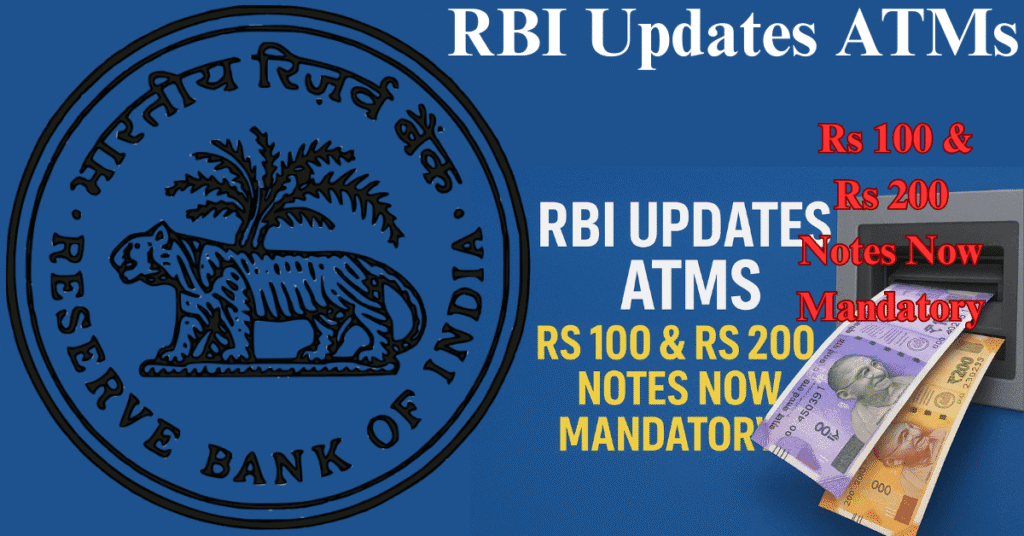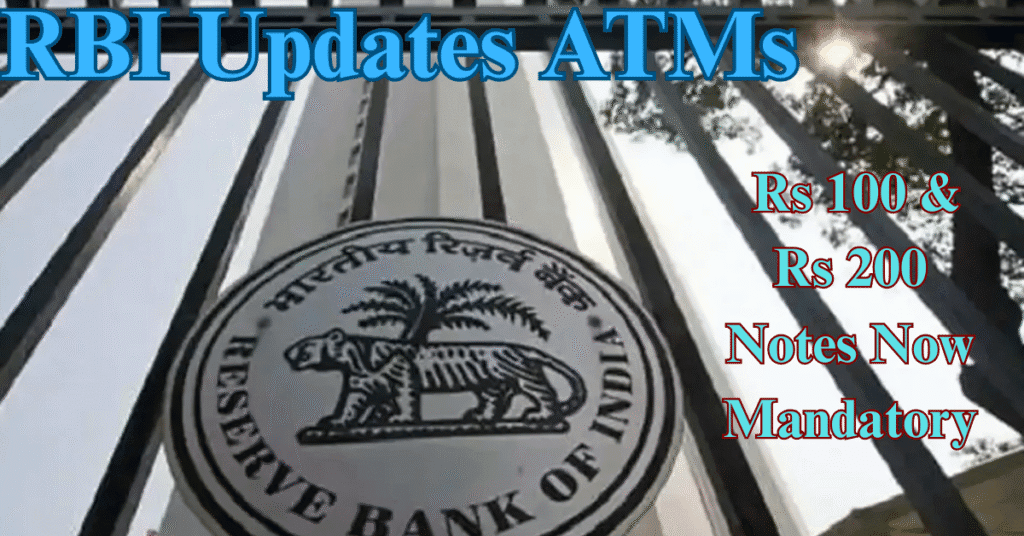
Table of Contents
RBI Updates ATMs
RBI Updates ATMs : RBI Makes Rs 100 & Rs 200 Notes Mandatory in ATMs : In a significant move aimed at revolutionizing cash availability and enhancing consumer convenience, the RBI makes Rs 100 & Rs 200 notes mandatory in ATMs across the nation. This directive, part of a broader strategy to optimize currency management, addresses long-standing public grievances regarding the non-availability of lower-denomination notes from automated teller machines. This strategic decision by the Reserve Bank of India is poised to significantly improve the everyday transactional experience for millions of Indians, ensuring smoother and more efficient cash withdrawals.
The move is not just about convenience; it’s a calculated effort to streamline the currency distribution system, reduce the logistical burden on banks, and promote the usage of ATMs for smaller, daily cash needs. For the average citizen, this means a higher probability of receiving smaller denomination notes when withdrawing cash, reducing the hassle of finding change for everyday expenses.
RBI Updates ATMs
Understanding the RBI Directive: What Exactly Has Been Mandated?
The Reserve Bank of India’s circular is precise and targeted. The central bank has instructed all banks and white label ATM operators (WLAs) to ensure that their ATMs are configured and replenished with an adequate number of ₹100 and ₹200 denomination banknotes.
The directive emphasizes the need for a balanced mix of denominations in each machine. The core objective is to prevent a scenario where ATMs are stocked solely with high-value ₹500 and ₹2,000 notes, which often creates inconvenience for users who need smaller amounts for daily use. By mandating that a specific proportion of cassettes within an ATM be dedicated to these lower denominations, the RBI makes Rs 100 & Rs 200 notes mandatory in ATMs a operational reality rather than just a recommendation.
This proactive approach ensures that the supply of these smaller notes is consistent and reliable, directly addressing the demand from a large section of the populace, including small vendors, commuters, and households.
RBI Updates ATMs

The Core Reasons Behind the RBI’s Strategic Move
Why has the RBI taken this step now? The decision is rooted in several key factors that impact both the economy and the common man.
- Enhancing Customer Convenience: The primary driver is overwhelmingly customer-centric. For years, ATM users have faced the frustration of withdrawing a few hundred rupees only to receive a single ₹500 or ₹2,000 note. Breaking these high-value notes for small purchases has been a persistent challenge. This move directly solves that problem.
- Optimizing Currency Management: From a systemic perspective, it helps in better currency management. Encouraging the use of lower denominations for small transactions reduces the wear and tear on higher-value notes and creates a more efficient flow of currency across the system.
- Promoting Digital & Small-Value Transactions: While India is pushing for digital payments, cash remains king for micro-transactions. Ensuring easy access to ₹100 and ₹200 notes facilitates small purchases, supporting a vast network of small merchants and the informal economy who rely on cash transactions.
- Improving ATM Operational Efficiency: A common complaint has been ATMs running out of cash. By diversifying the denomination mix, the RBI is also ensuring that an ATM is less likely to become completely non-functional. If ₹500 notes are exhausted, the machine can still dispense ₹100 and ₹200 notes, thereby continuing to serve customers.
The Practical Impact on Consumers and Daily Life
The directive that the RBI makes Rs 100 & Rs 200 notes mandatory in ATMs will have a tangible, positive impact on the daily lives of consumers.
- Easier Small Withdrawals: Individuals can now withdraw smaller amounts like ₹300, ₹400, or ₹700 without worrying about getting a single high-value note that is difficult to use.
- Convenience for Small Vendors: Auto-rickshaw drivers, street vendors, tea stall owners, and small shopkeepers, who often struggle to provide change for a ₹500 note, will benefit immensely. They can now get smaller denominations directly from ATMs to support their business operations.
- Budget Management: For students and households on a strict budget, the ability to withdraw exact amounts helps in better daily financial planning and expense tracking.
- Reduced Dependency on Bank Branches: Previously, people had to visit bank branches and stand in queues specifically to get change. This directive should significantly reduce that need, decongesting branches and saving time.
Implementation Challenges and Bank Compliance
While the directive is clear, its implementation across India’s vast network of over 200,000 ATMs presents significant challenges for banks and ATM operators.
- Reconfiguring ATM Cassettes: Each ATM has a limited number of cassettes (usually 4). Banks will now have to dedicate one or two cassettes to ₹100 and ₹200 notes, which may require physical reconfiguration and recalibration of thousands of machines.
- Logistical Supply Chain: Ensuring a steady and uninterrupted supply of these lower-denomination notes to every ATM location is a massive logistical undertaking. It requires coordination between the RBI, currency chests, and cash-in-transit companies.
- Cash Management Strategies: Banks will need to overhaul their cash loading strategies. The proportion of each denomination loaded will need to be carefully analyzed based on the location of the ATM (e.g., a commercial area vs. a residential colony) to meet localized demand effectively.
The RBI has given banks a strict timeline to comply with these new norms, and it will be a key area to monitor in the coming months.
The Bigger Picture: RBI’s Evolving Approach to Currency Management
This move is not an isolated event but part of a series of measures taken by the RBI to modernize and humanize India’s currency ecosystem. It follows the introduction of the ₹200 note itself in 2017, which was aimed at filling the “missing middle” between the ₹100 and ₹500 notes.
The directive underscores the RBI’s commitment to ensuring that the physical currency system remains robust, user-friendly, and efficient, even as the country marches towards digitalization. It acknowledges the continued importance of cash in the Indian economy and seeks to make its usage as frictionless as possible.
Looking Ahead: The Future of ATMs and Cash Withdrawals
The mandate that the RBI makes Rs 100 & Rs 200 notes mandatory in ATMs signals a new future for ATMs in India. They are evolving from being mere cash-dispensing machines to becoming sophisticated touchpoints for customized financial service.
We can expect further innovations, such as:
- Dynamic Currency Dispensation: ATMs that can intelligently dispense a mix of denominations based on the withdrawal amount requested.
- Enhanced Accessibility: Features that make it easier for visually impaired individuals to identify different notes.
- Multi-Functional Machines: ATMs that offer a wider range of banking services beyond just cash withdrawal.
This directive is a foundational step towards building a more inclusive and efficient cash distribution network for the world’s largest democracy.
Conclusion: A Welcome Change for a Cash-Based Economy
The RBI’s directive is a powerful and praiseworthy intervention that puts citizen convenience at the forefront of monetary policy implementation. By ensuring that RBI makes Rs 100 & Rs 200 notes mandatory in ATMs, the central bank has addressed a decades-old pain point for the average Indian.
While banks face a challenging implementation phase, the long-term benefits for the economy and the public are substantial. This move reaffirms the RBI’s role not just as a monetary authority but also as a facilitator of smooth and efficient everyday economic activity.
Stay updated with the latest financial news and RBI circulars. [Internal Link to your Banking News Category] For more details on how this affects your banking habits, consult your local bank branch.
#RBI #ATM #Currency #BankingNews #Rs100Notes #Rs200Notes #IndianEconomy #CashLiquidity
FAQs Section
Q1: Does this mean ATMs will no longer dispense ₹500 and ₹2000 notes?
A: No, not at all. The directive ensures a balanced mix. ATMs will continue to dispense ₹500 and ₹2000 notes, but they will now be required to also hold and dispense a mandatory supply of ₹100 and ₹200 notes.
Q2: When will I start seeing this change at my local ATM?
A: The RBI has given banks a specific timeframe to comply. The rollout will be gradual as banks need to reconfigure machines and manage logistics. You should expect to see changes over the next few weeks and months.
Q3: Will this lead to more ATM outages or cash shortages?
A: The RBI’s intention is actually the opposite. By diversifying the denominations, an ATM is less likely to become completely empty. Even if one denomination runs out, it can continue to dispense others. However, initial teething problems with supply chains are possible.
Q4: Is the ₹2000 note being phased out?
A: This specific directive is not about phasing out the ₹2000 note. It is about improving the availability of lower denominations. The policy regarding ₹2000 notes is separate, and their circulation is naturally declining as they are not being printed anymore.
Q5: How can I be sure I’ll get ₹100 notes from an ATM?
A: You can select a specific withdrawal amount that is not a multiple of 500 (e.g., ₹300, ₹700, ₹900). With the new mandate, the machine’s software will be configured to provide this amount using a combination of available denominations, significantly increasing your chances of receiving ₹100 and ₹200 notes.


